Riding the Rail
Japan has one of the best rail systems in the world - in my humble opinion of course. It is possible, for example, to transverse alomst the entire length of Japan, from Hiroshima in the South to Aomori in the North - with only a single transfer - in less than a day. When the schedule says a train will leave at 9:23am it leaves at 9:23am; no sooner, no later. Further, with the exception of natural events (snow, earthquakes, etc.) they are rarely, if ever, late in arriving. This is as true for subway trains as it is for the super fast Shinkansen trains.
We have visited Japan on numerous occasions, and have always utilised the train network to its fully extent. The JR Rail Pass is the single most important item you can buy before departing for Japan. It is not only convenient, it is a real money saver. To illustrate this point, what follows it a dairy - of sorts - of our September 2015 trip to Hiroshima, Japan. Our visit was short - only 8 days, Saturday to Saturday - we nonetheless covered some distance.
Before leaving home we purchased two JR 'Green' Rail passes for ¥38,880 each. See this website for full details; JR Rail Pass
Day 1 - Fukuoka to Hiroshima
We Arrived in Fukuoka in the late afternoon Saturday. After taking the subway from the Domestic Airport (note: there is no subway connection from the international terminal. Take the free shuttle bus between terminals) to Hakata station, we exchanged our vouchers for the rail passes. We boarded the SHINKANSEN SAKURA 564 for Hiroshima - normal cost ¥12,530 - and relaxed for the 79mins journey.
Normal Ticket Price: ¥12,530
Cumulative Rail Pass Value: ¥12,530 (32% of purchase price)
Cumulative Distance Traveled: 280.7km
Day 2 - Walking Tour of Hiroshima
No train rides today. We instead opted for a self-guided tour of Hiroshima taking in the Hiroshima Castle, A-Bomb Dome, Peace Memorial, and Hondori Shopping Street.
 Hiroshima Castle, sometimes called Carp Castle, was constructed in the 1590s, but was destroyed by the atomic bombing on 6 August 1945. It was rebuilt in 1958, a replica of the original, which now serves as a museum of Hiroshima's history prior to World War II. It is representative of a 'flatland' castle.
Hiroshima Castle, sometimes called Carp Castle, was constructed in the 1590s, but was destroyed by the atomic bombing on 6 August 1945. It was rebuilt in 1958, a replica of the original, which now serves as a museum of Hiroshima's history prior to World War II. It is representative of a 'flatland' castle.
Hiroshima Castle is also called "Carp Castle" and is pronounced RIJO in Japanese. The area where the castle is built was known as Koi-no-ura (Koi Sea Shore) and "Koi" means carp in Japanese, so the castle was given the nickname 'Carp Castle' in later years.
For more information and images of Hiroshima Castle please see the 'Castles' page.
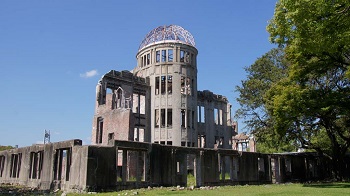 A-Bomb Dome, which was designed by a Czech architect in 1915, had been used as the Hiroshima Prefecture Industrial Promotion Hall. Whilst the Hiroshima Prefecture Industrial Promotion Hall was located only 160 meters from the hypo-center, the building was not destroyed. The Hiroshima Peace Memorial is the only structure left standing near the hypo-center of the first atomic bomb which exploded on 6 August 1945, and it remains in the condition right after the explosion.
A-Bomb Dome, which was designed by a Czech architect in 1915, had been used as the Hiroshima Prefecture Industrial Promotion Hall. Whilst the Hiroshima Prefecture Industrial Promotion Hall was located only 160 meters from the hypo-center, the building was not destroyed. The Hiroshima Peace Memorial is the only structure left standing near the hypo-center of the first atomic bomb which exploded on 6 August 1945, and it remains in the condition right after the explosion.
The most important meaning of the surviving structure of the Hiroshima Peace Memorial is in what it symbolizes, rather than just its aesthetic and architectural values. It symbolizes the tremendous destructive power, which humankind can invent on the one hand; on the other hand, it also reminds us of the hope for world permanent peace. It was designated a UNESCO World Heritage Site in 1996 and has been representing people's prayers for a lasting peace.
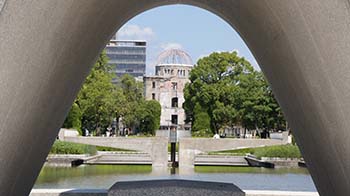 Hiroshima Peace Memorial Park, is located in the middle of Hiroshima city that contains several memorials to the atomic bomb victims of Hiroshima, including the Hiroshima Peace Memorial Museum, The Memorial Cenotaph, The Flame of Peace and the The Children’s Peace Monument.
Hiroshima Peace Memorial Park, is located in the middle of Hiroshima city that contains several memorials to the atomic bomb victims of Hiroshima, including the Hiroshima Peace Memorial Museum, The Memorial Cenotaph, The Flame of Peace and the The Children’s Peace Monument.
The Memorial Cenotaph located near the center of the park is an arched tomb for the victims of the bomb. A stone chest below the arch holds a register that contains all the known names of those who lost their lives as a result of the bombing. It is designed in a traditional Shinto style, to provide protection to the souls of the victims. The cenotaph carries the epitaph, “Let all souls here rest in Peace, for we shall not repeat the evil.”
The Flame of Peace is shaped symbolising two hands held palm upwards. It is designed to reflect the victims who were unable to satisfy their thirst for water. It was built to express the desire for the abolition of all nuclear weapons and has been alight since August the 1st 1964. It will be extinguished once all of the nuclear weapons on earth have been destroyed.
When taken at the right angle it is possible to line up the A-Bomb Dome, the Flame of Peace and the Cenotaph in a single photograph.
Day 3 - Himeji and Okayama Castles
Back on the rail today for the first of three Castle trek days; today Himeji and Okayama Castles. Himeji is a leisurely 61 mins ride on the SHINKANSEN SAKURA from Hiroshima. We departed at 9:53 and arrived at 10:54. Exit the Himeji station via the North exit and the castle will be visible in the distance. We decided to walk the 1000m to the main castle gate. There are buses and taxis located directly outside the station exit if you prefer.
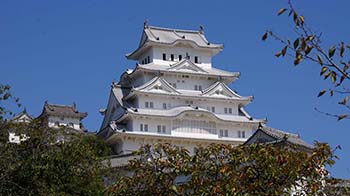 Himeji Castle, (姫路城, Himejijō), also known as White Heron Castle (Shirasagijo) due to its elegant, white appearance, is widely considered Japan's most spectacular castle for its imposing size and beauty and its well preserved, complex castle grounds. The castle is both a national treasure and a world heritage site. Unlike many other Japanese castles, it was never destroyed by war, earthquake or fire and survives to this day as one of the country's twelve original castles.
Himeji Castle, (姫路城, Himejijō), also known as White Heron Castle (Shirasagijo) due to its elegant, white appearance, is widely considered Japan's most spectacular castle for its imposing size and beauty and its well preserved, complex castle grounds. The castle is both a national treasure and a world heritage site. Unlike many other Japanese castles, it was never destroyed by war, earthquake or fire and survives to this day as one of the country's twelve original castles.
It was constructed in the mid-14th century, and a three-layer castle tower was built by Toyotomi Hideyoshi in the 16th century. Ikeda Terumasa, a feudal Lord of the castle remodeled it in the 17th century. Its figure was likened to a white heron spreading wings, and thus also called White Heron Castle.
For more information and images of Himeji Castle please see the 'Castles' page.
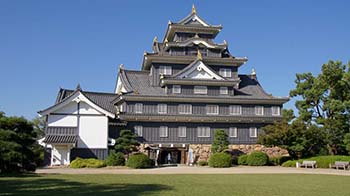 Okayama Castle, was completed in 1597 after eight years of construction, under the direction of Hideie Ukita, a daimyo of the Sengoku Period. Because the castle was oriented to the west, Hideie undertook a major project to pull the nearby Asahigawa River to flow along the eastern end of the castle to ward off enemies from entering through the rear. The architecture of the period is partly represented by the use of boards painted with black lacquer on the walls of the castle tower (Tenshukaku). As such, the exterior is black, and in the later periods, the castle came to be known as the Crow Castle (Ujo). Hideie not only used Okayama Castle as a military facility, but also called in merchants and craftsmen around the castle's domain to develop a castle town.
Okayama Castle, was completed in 1597 after eight years of construction, under the direction of Hideie Ukita, a daimyo of the Sengoku Period. Because the castle was oriented to the west, Hideie undertook a major project to pull the nearby Asahigawa River to flow along the eastern end of the castle to ward off enemies from entering through the rear. The architecture of the period is partly represented by the use of boards painted with black lacquer on the walls of the castle tower (Tenshukaku). As such, the exterior is black, and in the later periods, the castle came to be known as the Crow Castle (Ujo). Hideie not only used Okayama Castle as a military facility, but also called in merchants and craftsmen around the castle's domain to develop a castle town.
For more information and images of Okayama Castle please see the 'Castles' page.
Hiroshima to Himeji Normal Ticket Price: ¥11,880 (249.9km)
Himeji to Okayama Normal Ticket Price: ¥4,500 (88.6km)
Okayama to Hiroshima Normal Ticket Price: ¥8,250 (161.3km)
Cumulative Rail Pass Value: ¥37,160 (95% of purchase price)
Cumulative Distance Traveled: 749.7km
Day 4 - Matsue Castle
Back on the rail today for the second of three Castle trek days; today Matsue. Matsue is somewhat of a hike from Hiroshima, and involves a transfer at Okayama Station onto the LTD. EXP YAKUMO train. Whilst comfortable enough, the Yakumo is smaller and slower than the Shinkansen trains. They also rock and roll a lot more. So anyone with a tendency for motion sickness should consider taking some anti-motion sickness pills. The ride from Okayama to Matsue is 153mins each way; bring a good book!
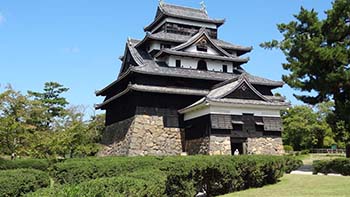 Matsue Castle, (Matsue-jo) was built by the daimyo Horio Yoshiharu, who governed the region of the present Shimane Prefecture, over a period of five years starting 1607. All the buildings which functioned as a castle were demolished except for the donjon and the stone wall when political power passed from the Edo shogunate to the Meiji government. The donjon, which is designated one of Japan's Important Cultural Properties, has five tiers and is about 30 m tall. It is characterized by a structure designed for actual warfare with a well for underground siege, and the top floor is an observation level.
Matsue Castle, (Matsue-jo) was built by the daimyo Horio Yoshiharu, who governed the region of the present Shimane Prefecture, over a period of five years starting 1607. All the buildings which functioned as a castle were demolished except for the donjon and the stone wall when political power passed from the Edo shogunate to the Meiji government. The donjon, which is designated one of Japan's Important Cultural Properties, has five tiers and is about 30 m tall. It is characterized by a structure designed for actual warfare with a well for underground siege, and the top floor is an observation level.
Architecturally unique, the Castle's five-storied facade actually conceals six fighting floors. Unlike most castle foundations in Japan which are characterized by large, uniformly cut and fitted blocks, Matsue Castle sits atop a foundation comprised of irregular-sized stones placed with the smallest surface out and chocked into place with smaller rocks.
For more information and images of Matsue Castle please see the 'Castles' page.
Hiroshima to Matsue (via Okayama) Return Normal Ticket Price: ¥28,940 (698.6km)
Cumulative Rail Pass Value: ¥66,100 (170% of purchase price)
Cumulative Distance Traveled: 1448.3km
Day 5 - Matsuyama Castle
Back on the rail today for the third of three Castle trek days; today Matsuyama. Matsuyama is further from Hiroshima than Matsue, and also involves a transfer at Okayama Station, this time onto the LTD. EXP SHIOKAZE train. Like the Yakumo the Shiokaze is smaller and slower than the Shinkansen trains. And, like the Yakumo they also rock and roll a lot more. The ride from Okayama to Matsue is 165mins each way.
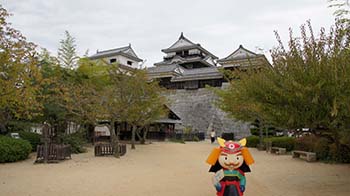 Matsuyama Castle (Matsuyama-jo), with its construction starting in 1603, was completed in 1627 by Kato Yoshiaki, who had once served under the hegemon Toyotomi Hideyoshi, the ruler of Japan in the latter half of the 16th century. It stands on the summit of Katsu-yama, which is positioned almost in the middle of Matsuyama, and the castle building, stone walls and moat with the donjon at the center retain their former images well. The donjon was originally a five-tiered building but was renovated as a three-tiered structure in the 17th century. This donjon was destroyed in a fire afterwards, and the existing one was built in 1854. The exterior shows a slight curvature in the small triangular gables on the roof and is nothing ostentatious. Fine, thick pieces of timber are used for the interior, however.
Matsuyama Castle (Matsuyama-jo), with its construction starting in 1603, was completed in 1627 by Kato Yoshiaki, who had once served under the hegemon Toyotomi Hideyoshi, the ruler of Japan in the latter half of the 16th century. It stands on the summit of Katsu-yama, which is positioned almost in the middle of Matsuyama, and the castle building, stone walls and moat with the donjon at the center retain their former images well. The donjon was originally a five-tiered building but was renovated as a three-tiered structure in the 17th century. This donjon was destroyed in a fire afterwards, and the existing one was built in 1854. The exterior shows a slight curvature in the small triangular gables on the roof and is nothing ostentatious. Fine, thick pieces of timber are used for the interior, however.
For more information and images of Matsuyama Castle please see the 'Castles' page.
Hiroshima to Matsuyama (via Okayama) Return Normal Ticket Price: ¥34,100 (751.4km)
Cumulative Rail Pass Value: ¥100,200 (257% of purchase price)
Cumulative Distance Traveled: 2199.7km
Day 6 - Miyajima: Itsukushima Shrine
Short trip today to visit the Itsukushima Shrine, perhaps the most famous, and most recognised, Torii Gate. If you've ever seen a picture of a red Torii gate located in water, it's likely to have been the one at Itsukushima. We used the JR Subway and Ferry, which are both free with the Rail Pass.
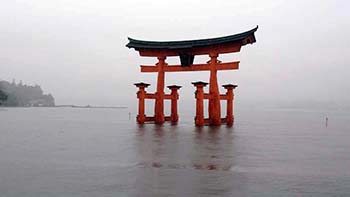 Miyajima Island, one of the most scenic spots in Japan, has long been regarded as an Island of Gods on the beautiful Seto Inland Sea. It is a romantic and historical island where Itsukushima Shrine, a World Heritage site, is located, along with the Virgin Forest of Mt. Misen, and numerous preserved shrines, temples and historical monuments.
Miyajima Island, one of the most scenic spots in Japan, has long been regarded as an Island of Gods on the beautiful Seto Inland Sea. It is a romantic and historical island where Itsukushima Shrine, a World Heritage site, is located, along with the Virgin Forest of Mt. Misen, and numerous preserved shrines, temples and historical monuments.
The centuries-old Itsukushima Shrine (厳島神社, Itsukushima Jinja) on Miyajima is the source of both the island's fame and its name. Formally named Itsukushima, the island is more popularly known as "Miyajima", literally "shrine island" in Japanese, thanks to its star attraction. The shrine is known worldwide for its iconic "floating" torii gate.
The shrine and its torii gate are unique for being built over water, seemingly floating in the sea during high tide. The shrine complex consists of multiple buildings, including a prayer hall, a main hall and a noh theater stage, which are connected by boardwalks and supported by pillars above the sea.
Miyajima Island has a long history as a holy site of Shinto. The island's highest peak, Mount Misen, was worshiped by local people as early as the 6th century. In 1168, Taira no Kiyomori, the most powerful man in Japan during the end of the Heian Period, selected the island as the site of his clan's family shrine and built Itsukushima Shrine.
The shrine is located in a small inlet, while the torii gate is set out in the Seto Inland Sea. Paths lead around the inlet, and visitors enjoy walking along them while looking out onto the sea. After sunset, the shrine and the torii gate are illuminated daily until 23:00, providing a perfect backdrop for ryokan guests to enjoy an evening walk in yukata and geta sandals. It is not possible to enter the shrine after sunset, though.
Hiroshima to MIYAJIMAGUCHI (via JR Sanyo Line) Return Normal Ticket Price: ¥820 (22.8km)
MIYAJIMAGUCHI to Miyajima (via JR Miyajima Ferry) Return Normal Ticket Price: ¥360
Cumulative Rail Pass Value: ¥101,380 (260% of purchase price)
Cumulative Distance Traveled: 2222.6km
Day 7 - Back to Fukuoka
Last day in Hiroshima today before heading back down to Fukouka. Also our last chance to use the 7-day Rail Pass. As can be seen from the below final summary, buying the Rail Pass saved us a substantial amount on our travel plans. The Pass paid for itself by the 2nd day. Had we purchased the tickets individually we would have paid 3 times as much.
There are of course some restrictions when using the Rail Pass. For example, you can't book tickets on the Nozomi and other express Shinkansens. You also have to go to the ticket office to book your seats - you can't do it through the ticket machines. These are, however, easily overcome by booking your tickets the day before, or allowing extra time on the day of travel - the ticket offices can be busy!
Hiroshima to Hakata (Fukouka) Normal Ticket Price: ¥12,530 (228.7km)
Cumulative Rail Pass Value: ¥113,910 (292% of purchase price)
Cumulative Distance Traveled: 2503.3km